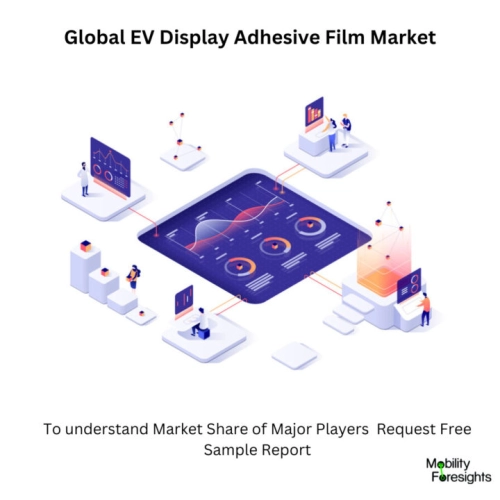
- Get in Touch with Us

Last Updated: Apr 25, 2025 | Study Period: 2023-2030
EV Display Adhesive film are applied as solids, often have no constraints on pot life, and are safe for the environment. The glue cures in place and any "squeeze out" is prevented when the cure heat is applied.
The performance and processing properties of films can be consistently reproduced from one production process to the next, and they are available in thicknesses ranging from 2 to 8 mils.
In comparison to cold-cured two-part adhesive polymer, hot-cured epoxy adhesive films are a more durable adhesive and display strong moisture and chemical resistance.
At slightly higher temperatures, they have quick cure rates, but the manufacturer should provide you the precise numbers. Additionally, they can be stored for a long time even at room temperature, however refrigeration is advised.
Similar to the two-part cold-cure adhesive, the adhesive film needs to be compatible with the polymer matrix of the FRP composite.
GLOBAL EV DISPLAY ADHESIVE FILM MARKET SIZE AND FORECAST

The Global EV Display Adhesive film market accounted for $XX Billion in 2022 and is anticipated to reach $XX Billion by 2030, registering a CAGR of XX% from 2023 to 2030.
A series of EV Display Adhesive film for vehicle displays has been created by Schreiner ProTech, a global developer of functional labels for the automotive and engineering-based industries.
The supply chain trip, from production to transport to installation, is protected by these adhesive film solutions against dust, scratches, and other damage.
It's crucial to reduce the possibility of electrostatic discharge (ESD) when removing the coating without residue. In light of this, the new protection films from Schreiner Protech lessen the possibility of electric flashovers when they are peeled off a display.
As a result, there is a noticeably reduced risk of human static electric shocks and electronic component damage.
The display protection films from Schreiner ProTech come in a wide range of dimensions, including a selection of larger, taller films to accommodate increasingly huge displays.
The films can have processing data imprinted on them to make human application easier or to allow for fully automated application. Layouts can be altered to meet specific requirements, and a built-in tab makes film removal simple.
| Sl no | Topic |
| 1 | Market Segmentation |
| 2 | Scope of the report |
| 3 | Abbreviations |
| 4 | Research Methodology |
| 5 | Executive Summary |
| 6 | Introduction |
| 7 | Insights from Industry stakeholders |
| 8 | Cost breakdown of Product by sub-components and average profit margin |
| 9 | Disruptive innovation in the Industry |
| 10 | Technology trends in the Industry |
| 11 | Consumer trends in the industry |
| 12 | Recent Production Milestones |
| 13 | Component Manufacturing in US, EU and China |
| 14 | COVID-19 impact on overall market |
| 15 | COVID-19 impact on Production of components |
| 16 | COVID-19 impact on Point of sale |
| 17 | Market Segmentation, Dynamics and Forecast by Geography, 2023-2030 |
| 18 | Market Segmentation, Dynamics and Forecast by Product Type, 2023-2030 |
| 19 | Market Segmentation, Dynamics and Forecast by Application, 2023-2030 |
| 20 | Market Segmentation, Dynamics and Forecast by End use, 2023-2030 |
| 21 | Product installation rate by OEM, 2023 |
| 22 | Incline/Decline in Average B-2-B selling price in past 5 years |
| 23 | Competition from substitute products |
| 24 | Gross margin and average profitability of suppliers |
| 25 | New product development in past 12 months |
| 26 | M&A in past 12 months |
| 27 | Growth strategy of leading players |
| 28 | Market share of vendors, 2023 |
| 29 | Company Profiles |
| 30 | Unmet needs and opportunity for new suppliers |
| 31 | Conclusion |
| 32 | Appendix |